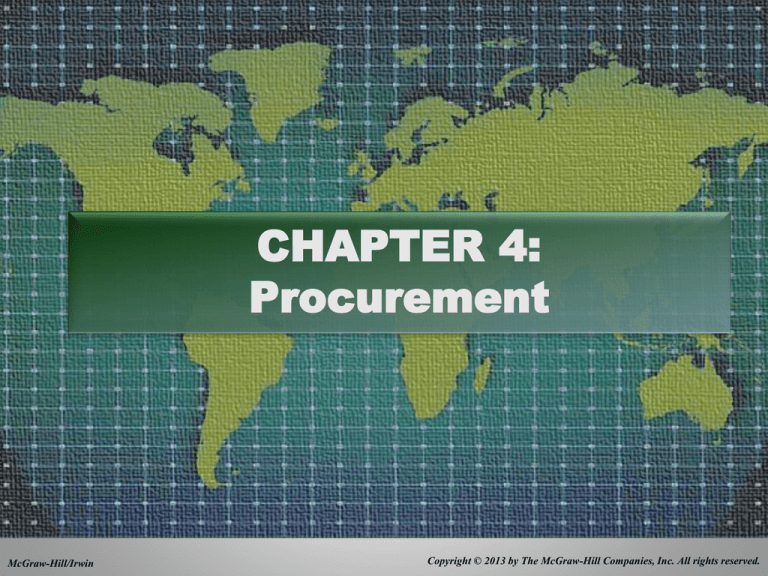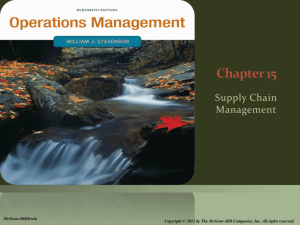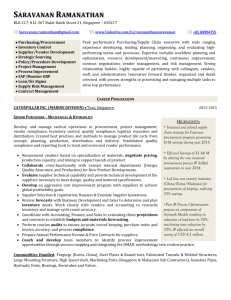
CHAPTER 4:
Procurement
McGraw-Hill/Irwin
Copyright © 2013 by The McGraw-Hill Companies, Inc. All rights reserved.
Overview of procurement
• Procurement objectives
• Procurement strategy
• Supplier selection and
assessment
• Logistical interfaces with
procurement
4-2
Procurement is now a strategic activity of
the firm
• Several factors have elevated the
importance of procurement to the
firm
– Purchased goods and services are
among the largest cost elements for
most firms
– The growing emphasis of
outsourcing has expanded the
supply base of organizations
• This added complexity requires more
management attention on the
organizational interfaces with suppliers
4-3
Purchasing perspective
• Purchasing was historically perceived as just a buying
function for manufacturing and repair materials and
supplies
– Purchasing agent tried to get lowest price possible for acceptable
quality
– Transactional focus led to getting the best possible “deal” today
• Did not focus on future transactions
– No concept of Supply Chain
• Purchasing seldom looked beyond the first-tier supplier
– Purchasing simply responded to demands of production group
4-4
Purchasing perspective
• Procurement is an organizational capability that ensures
the firm is positioned to implement its strategies with
support from its supply base
– Procurement looks up and down the entire supply chain for
impacts and opportunities
• Goods and service account for 55 cents of every sales dollars
– Focuses on building relationships with suppliers and downstream
customers
– Involvement with outsourcing includes more than just purchasing
raw materials and parts
• Also includes finding alternate sources for manufactured products or
services to help manage demand
4-5
Procurement focuses on several issues
related to the firms’ supply base
•
•
•
•
Ensuring continuous supply
Minimizing inventory investment
Quality improvement of supply
Supplier development
– Supplier selection
– Building supplier relationships
– Supplier continuous improvement
• Lowest total cost of ownership
4-6
Figure 4.1 - Major categories for the
components of total cost of ownership
4-7
Procurement strategies
• Insourcing vs. outsourcing
– Make vs. buy decision
• Alternative procurement strategies
– User buy
• Volume consolidation
• Reducing total number of suppliers while minimizing
risk
– Supplier operational integration
• Building partnerships
• Sharing information and knowledge
• Identifying linked processes and shared
opportunities for improvement
– Value management extends beyond buyerseller operations
• Involving the supplier early in product design
• Reducing complexity
• Value engineering
4-8
Savings potential from volume consolidation
• Purchases average 55% of every sales dollar
• Cost savings estimated between 5% to 15% of
purchases
• Potential savings is $5.5 million annually for a
company with revenues of $100 million
4-9
Supplier operational integration
• Primary objective of operational integration is to cut waste,
reduce cost, and develop a relationship that allows both
buyer and seller to achieve mutual improvements
• Integration can take many forms
– Buyer providing detailed sales information to supplier
– Buyers and suppliers working together to redesign linked
processes
– Eliminating duplicated activities performed by both the buyer and
supplier
• Can provide incremental savings of 5% to 25% over the
benefits of volume consolidation
4-10
Value management through early
supplier involvement in product design
Figure 4.2 Flexibility and Cost of Design Changes
4-11
Procurement strategy portfolio
•
•
•
•
Routine purchases
Bottleneck purchases
Leverage purchases
Critical purchases
4-12
Figure 4.3
Procurement strategy matrix
High Level of
Supply Risk
Low Level of
Supply Risk
Bottleneck
Purchases
Multiple Suppliers
Routine Purchases
Reduce Buying
Effort
Critical Purchases
Integrated with
Suppliers
Leverage
Purchases
Concentrate
Purchases
Low Value to Firm High Value to Firm
Adapted from Robert Monczka et al., Purchasing and Supply Chain Management, 4th Edition
(Mason, OH: South-Western Cengage Learning, 2009), P. 211.
4-13
Supplier selection and assessment
•
•
•
•
•
Supplier audits
Supplier development
Monitoring performance
Supplier certification
E-commerce and procurement
– Electronic data interchange (EDI)
– Internet
4-14
E-Commerce and procurement
• Electronic Data Interchange (EDI) is the
electronic transmission of data between a firm
and its suppliers
– Shares information and knowledge such as order
entry, planning/scheduling, tracking, delivery, billing
and payment
• Internet-based communications offer several
opportunities for making product information
available while overcoming compatibility issues
between computer systems
– Electronic catalogs allow rapid access to product
info, specifications, pricing and ordering
– Buying exchanges allow sellers or buyers of specific
goods or services to find each other on a common
web site
4-15
Figure 4.4
Example supplier scorecard
Category
Weight
Score (100
maximum points)
Weighted Score
Correct quantities
.15
95
14.25
No defective items
.10
100
10.00
All shipments on time
.15
80
12.00
Correct
documentation
.10
95
9.50
No damage
.05
90
4.50
Flexibility
.10
80
8.00
Responsiveness
.20
90
18.00
Communication
.15
90
13.50
TOTAL
1.00
89.75
4-16
Purchase requirement segmentation
• Pareto Principle is a small percentage of
items account for a large percentage of
the dollars spent
– For example, “A” items in ABC inventory
• Purchasing processes should be tailored
to the value and/or criticality of the
materials needed
• Segmented approach is used to prioritize
resources for purchasing
– The most procurement effort goes to the most
critical supplies/suppliers
4-17
Logistics interfaces with procurement
• Just-in-Time
– JIT delivery
• More frequent delivery of smaller quantities
• Close cooperation and communication
– JIT II
• Integration of suppliers into manufacturing processes
• Procurement of logistics services
• Performance-based logistics
4-18
Performance based logistics interface
• Initiated by US Department of
Defense to purchase
performance outcomes instead
of individual transactions
defined by product
specifications
• Government specifies desired
outcomes and lets suppliers
determine the best way to meet
those requirements
• Currently limited to government
purchasing but business
organizations are expected to
adopt the practice
4-19








